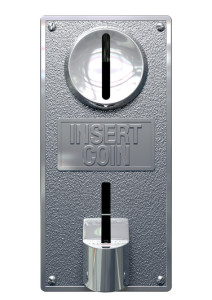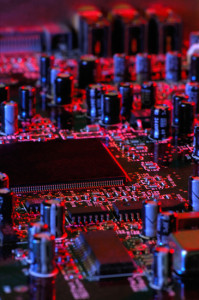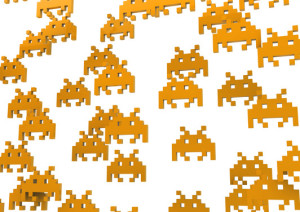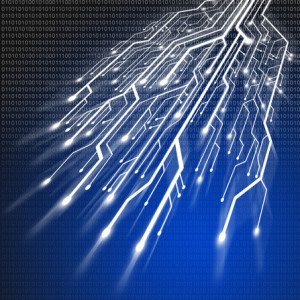#1. Mechanical Music
It seems obvious to us now, but the very first arcade games didn’t have any music. And the reason that music was added is probably not the reason you’d expect!

The way that the game companies got around the law was to add a simple music box and declare the games coin-operated “music machines”, where the player would always hear a song, even if they lost the game. That way, they were paying to hear the music, not to gamble on the game! If the police showed up, the arcades would quickly put up a sign on the game that read,
“This is not a gaming device. Any person desiring to gamble must not put any money in this machine. As a consideration for the use of this music machine and the music furnished, it is expressly agreed that all for the nickels which come out of the cup below must and shall be played back into the machine, thereby giving more music.”
#2. The Solenoid
What the heck is a solenoid? It’s actually quite simple, and you can even make one pretty quickly yourself! A coil of metal wire (such as copper) has an electrical current applied to it, which makes the coil become magnetized. That pulls anything magnetic towards it—like a metal rod. Release the electrical current, and the rod releases. The strength of the moving rod was used to bang on a bell, piece of wood, or a metal “strike” plate to make a loud sound. It’s the same concept that drives your doorbell. A solenoid drives the sound of the “the knocker” on a pinball machine, but was also the main way to make other sound effects until the rise of electronic games.
The first game to use a solenoid-driven sound effect outside of just ringing a bell was a primitive version of a shooter-meets-pinball, Rock-Ola’s Big Game of 1935. It used a solenoid to drive a hammer to strike a plate to sound like a gunshot.
It might seem obvious to us now, but at the time the game company even took out a patent on the idea. One of the advertisements for the game claimed, “Big Game’s sound effects idea is doing for pin games what the talkies did for moving pictures–making them more popular and more profitable”.
Video game sound might never have happened if the early pioneers didn’t show players how valuable sound was
Ask any pinball enthusiast—pinball would have never been the same without it, and video game sound might never have happened if the early pioneers didn’t show players how valuable sound was!
#3. Sound synthesis
Sounds can be synthesized (created from “nothing”) by using electrical signals to imitate sound waves. This can be done with analog signals, by fluctuating the voltage of the signal, or this can be done digitally using a computer. Early video games (in the arcades) used analog synthesis sound, but digital sound was used in nearly all of the home consoles we’re familiar with. Without the ability to synthesize sound, our video games would have be pretty quiet up until the advent of the CD-ROM!
#4. Dedicated Sound Chips and Sound Cards

Sound Cards for personal computers in the 1980s and 1990s were made of sound chips, but the fact that many people had different brands of cards, with slightly different sound variations, meant that game music and sound didn’t always sound the same on everyone’s devices.
Today, “chiptunes” composers use early sound chips to make interesting music, although sound chips are not often used anymore in most game devices.
#5. MIDI
MIDI, or Musical Instrument Digital Interface, was a standard developed in 1983 to help combat the fact that everyone’s sound cards were different (see #4, above!). Initially MIDI enabled a standard way for music keyboards to be integrated into DAWs (see #6), meaning everyone was using the same type of interface cable, instead of the issue we have today with some people using Mac-only hardware like Lightning bolt cables, and some people using Firewire. I have loads of hardware that I have to keep buying adaptors for every time I upgrade my computer. Standards help take away that problem, so MIDI was ahead of its time.
Later, when the General MIDI spec was introduced in 1991, it let composers and sound designers know exactly where you had which sound effect or which musical instrument sound available on your sound card.
Before MIDI, it was anyone’s guess what sound might come out of your card
General MIDI meant that if I played a game on my IBM, and you played one on your Tandy, we’d hear pretty much the same thing. There was still variation in the sound, since maybe I had a better sound card than you, but at least you’d hear the trumpet sound when the trumpet sound was supposed to play, instead of a bassoon! Before General MIDI, it was anyone’s guess what sound might come out of your card!
#6 The DAW, and Sequencers
Not all great inventions in game audio happened in hardware: The Digital Audio Workstation, or DAW, is a way of visualizing sound files to record, edit and produce sound and music. A DAW would include your hardware (including sound cards and music keyboards, see #4 and #5 above), but would add to that some important software (such as a sequencer), and usually some form of a MIDI controller (see above). By the mid 1980s, there was all kinds of software available to help musicians compose and record music.
Sequencers, for instance, will let you store information about music played in a sequence (the notes playing with and before/after each other). The DAW took the composition process to a whole new level, and spurred on a huge change in the sound of music more generally, as looping suddenly became a whole lot easier.
Popular on A Sound Effect right now - article continues below:
#7 Interactive Music
Although interactive music has been around for centuries, its use in games today has become a hallmark of a well-designed game.

Space Invaders was the first game in history to feature interactive music
The first interactive music in games was used in Space Invaders (1977): a simple descending four notes that sounded like a heartbeat that sped up as the levels progressed. Since then, interactive music has grown in leaps and bounds, and may adjust to the tiniest change in the game, like number of enemies in the area, or amount of ammo left. This makes it harder to play the game without the music turned on, making the music an integral part of the game.
#8 Surround Sound
We’d be remiss if we didn’t mention the role of surround sound in playing an awesome game. Surround sound was around in the arcades before the home, and you could sit in a seat that had speakers right behind your head. The first home PC soundcard to support surround sound was Diamond Monster Sound, in 1997. Since then, the sound has gotten a lot better, added more speakers (the latest consoles support 8 or 9 speakers in a 7.1 or 8.1 configuration).
You can even buy “virtual” surround sound headphones that will give you the surround sound experience without annoying your neighbours. Not all gamers use surround sound, but if they could hear games in surround, they’d probably change their minds and run out and get a surround system. Surround in film doesn’t usually add a whole lot—it’s usually just used for ambience. But in games, surround can tell you there’s a car about to take over (in a racing game), an enemy sneaking up (in a stealth or first person shooter), and lots more about what’s going on in the game that you’ll miss if you’re only in stereo (or—cringe—mono!). If you train your brain to listen, you’ll find that games today can even tell you about the size of a room by using software that emulates the patterns sound make as they reverberate around a space.
#9 Middleware
Sound middleware is the software that sits in “the middle” between the game’s composer/sound designer and the programming code. Middleware like Wwise and Fmod enable a composer to write interactive scores, and hear how their music will play back right in the game, lets sound designers easily add variation to their sound effects, and in general makes the process of getting sound into games a whole lot easier. It saves companies time, and while you might not care about that as a player, what that means is that they can afford to take the time to make great audio and get their games out faster to you!
#10 Real-Time DSPs and Procedural Generation
Alright, I’m cheating to put the two together here, but they kind of go together. DSPs (“digital signal processors”) are a fancy way of saying “effects”. When you walk into a cave in a game, and your footsteps change to match the boomy echo of the cave environment, that’s DSPs.
When your character goes underwater and the sound changes, that’s DSPs. “Real-Time” means the change in the sound can be processed by the computer at the time of the event, so sound designers don’t have to go and make a million versions of individual sounds, but can adjust them with DSPs!
Then the next big thing may be procedural generation of sound effects. Procedural generation of sound is still under-used in games, but it’s getting more advanced, and in the next five to ten years, you’re going to hear a lot more about it.
Have you played a game on the Kinect where you made a gesture, like a long sword swing, but your sound stopped half way through? That’s because a lot of games use sampled sound effects, and they can’t predict how long the sounds need to be, because your gestures are changeable. With procedural generation, sounds can be created (generated according to a set of procedures) on the fly, and respond to your action with the right length of sound. Does that sound futuristic? Don’t worry, it’s getting there.
Please share this:















































































































































































































































Hi Karen.
A few inaccuracies and things to clear up:
#5
MIDI is a transmission protocol that was designed to essentially allow one musical device to tell another when and what to play. What you are mostly talking about is General MIDI, which didn’t come about until 1991. General MIDI is a list of common sounds mapped to program numbers, along with a few other standard values mapped to possible features (such as filter cutoff mapped to CC#74).
At the time that General MIDI became relevant, there really wasn’t that much variation in sound cards on the PC. Back then you pretty much had Ad-lib or Soundblaster, and the Soundblaster was compatible with the Ad-lib, so there wasn’t an issue with audio sounding different on different soundcards. When newer soundcards began to contain a Wavetable ROM, General MIDI was used to standardise the sample sets used, but even then it was still a total mess. General MIDI only defined the sound names and nothing else about them. Each manufacturer had a different set of samples mastered differently meaning that the tones, and especially the volume levels, were all over the place. I remember having to create explicit MIDI files just for the AWE32, which was the biggest seller at the time, because it sounded so different to everything else. It really wasn’t the write-once-play-anywhere that people claimed it to be. In reality, it was an awful standard that was heavily biased towards orchestral/band music with a set of dreadful implementations. I would consider it a dark period in game audio, not least because sample playback was also available at the time and General MIDI delayed its widespread adoption in PC titles. Without General MIDI, it’s likely that PC games would have standardised on using MODs like the Amiga and PC music would have sounded a whole lot better a lot sooner.
MIDI has been a great thing for general music control, but it’s not like it set the world on fire as it was the next evolutionary step from CV Gate, which had been in use for 20 years prior to the introduction of MIDI. It also doesn’t really apply to Game Audio specifically. The invention and introduction of CD-ROM had a far greater impact as it allowed us to stream large quantities of streaming audio instead of being constrained by the limitations of the sound hardware.
#6
A DAW is an integrated hardware or software solution that includes a sequencer and multi-track recording capabilities. The introduction of the DAW didn’t really change anything apart from making things a bit easier (and in some cases a lot easier). I would argue again that this is not worthy of being an invention that changed game sound as it was another evolutionary step and more of an evolution of music creation in general rather than specifically game audio. Before computers got powerful enough to not require a ton of external hardware (like with the original ProTools), everything was done with a straight MIDI sequencer and a bunch of outboard gear. There isn’t fundamentally any difference between using a pure MIDI sequencer with an external multi-track recorder synched to time-code and a full-on DAW other than ease of cutting/pasting/copying recorded audio clips.
#8
It would be better to talk about 3D audio simulation rather than surround sound. Multi-speaker surround didn’t arrive until very late in the game after a successful marketing effort from Dolby and lackadaisical effort from Creative, who became a near-monopoly on the soundcard market. The Diamond Monster Sound used Aureal’s A3D binaural positioning technology, not multi-speaker surround sound. 3D positional audio got very advanced over the years and, unlike surround sound was in full 3D. Surround sound only allows 2D positioning as no speakers are positioned above or below you. There will always be arguments over the benefits of binaural sound over surround sound and vice-versa, but fundamentally they are all attempting to simulate the position of sound in 3D space, for which you should actually give the credit to Euclid, the Greek mathematician with a nod to Christian Doppler for his insights into the changing frequencies of waves emanating from objects in motion.
#10
A Digital Signal Processor is a hardware chip designed for processing of streaming data. Audio data is a stream, so DSPs lend themselves well to audio processing. However, they shouldn’t really be included as a separate entity as strictly speaking they are encompassed in #4. It’s not really right to call audio effects ‘DSPs’ although they do come under the banner of ‘Digital Signal ProcessING’.
Procedural sounds might never become the norm, just as raytracing might never become the norm for graphics rendering. What you describe as procedural is actually more common than you think, but is not really procedural sound. It’s a set of samples manipulated to be as interactive as possible. A simple example would be an elevator sound that consists of three samples: Start, operation and stop. On usage of the elevator, the game will play the start sample and immediately follow it with the operation sample, which will loop until the elevator begins its stop phase at which point the looping operation sample is stopped and the stop sample played. All of this is part of the audio programming implementation, which in most cases will be covered by the type of Middleware mentioned in #9.
One of the main barriers to real procedural sound in games is not the mathematics required (although the CPU required is fairly substantial) but the tools to design the sound. There needs to be a whole paradigm shift in sound tool design and game design tools to enable people to correctly setup physical audio properties for objects. A can of coke, for instance, would need to have the material of its thin body defined differently to the thick top and bottom and an audio designer would need access to the physical shape of the object as used by the game’s physics system. This would all need to be tied together in some form of scene editor and it all gets very complicated indeed. Whenever power increases, it gets given to everything but audio, so I can’t see a day when audio will be favoured enough to be given a fairly large percentage of CPU that could be used for graphics instead, especially when samples work so well.
Hi Mike
Great comments! I clarified the MIDI bit to make it more clear.
I disagree with you that the DAW, as an evolution, isn’t an invention. Pretty much every invention out there is an evolution if you want to dig into it. Take #1, the music in games, came from music boxes which came from large church barrel organs which came from early mechanical music machines created by the Ancient Greeks… etc. etc. etc. Yes, the DAW didn’t magically appear all together overnight as one complete unit, but as a concept, it is a very important step in computer music.
The rest, I think we’re splitting hairs on semantics. I don’t disagree with you, and perhaps I’ve oversimplified things too much by trying to use terminology that non-experts can understand. Point taken. I look forward to our conversations! :)
Hi Mike,
Good points..
I would disagree with you about the semantics of “DSP” though.
Although the origin of the term “DSP” clearly meant “Digital Signal ProcessOR” (i.e. a hardware chip designed to do math operations commonly used on digital signals very efficiently) it has certainly morphed into the more generic Digital Signal ProcessING. I.e. the generic processing of signals (sounds in our case), particularly when you’re talking about sound.
Real-time/Run-time DSP in games doesn’t refer to hardware anymore, but rather is a generic term for the processing of the signals (sounds) in real-time.
Brian Schmidt
Executive Director
http://www.GameSoundCon.com
The first most popular interactive music “engine” was Michael Z. Lands iMuse, used in Monkey Island 2. It switched between different arrangements and instrumentations related to the context of the game.
Ah, and if you refer to the dedicated sound chip of the c64….it’s called SID, and there are some very nice virtual instruments available that emulate this chip very accurate.